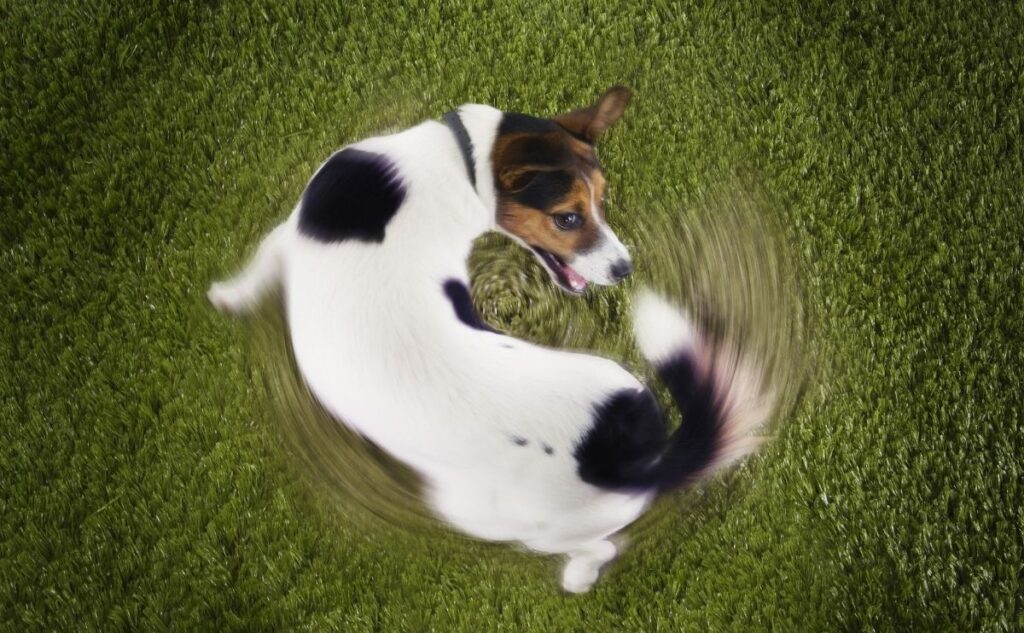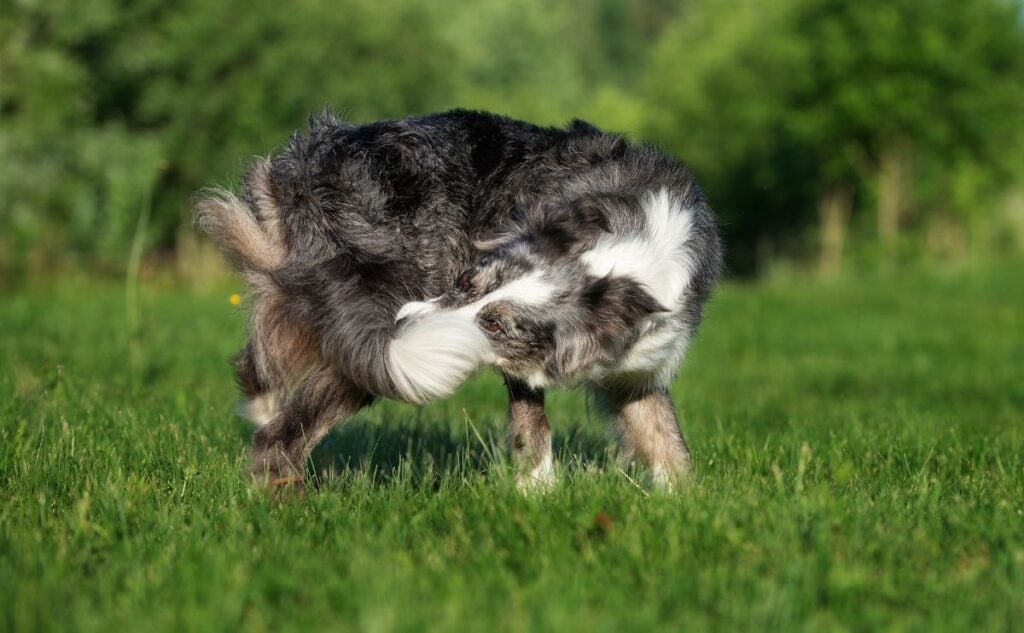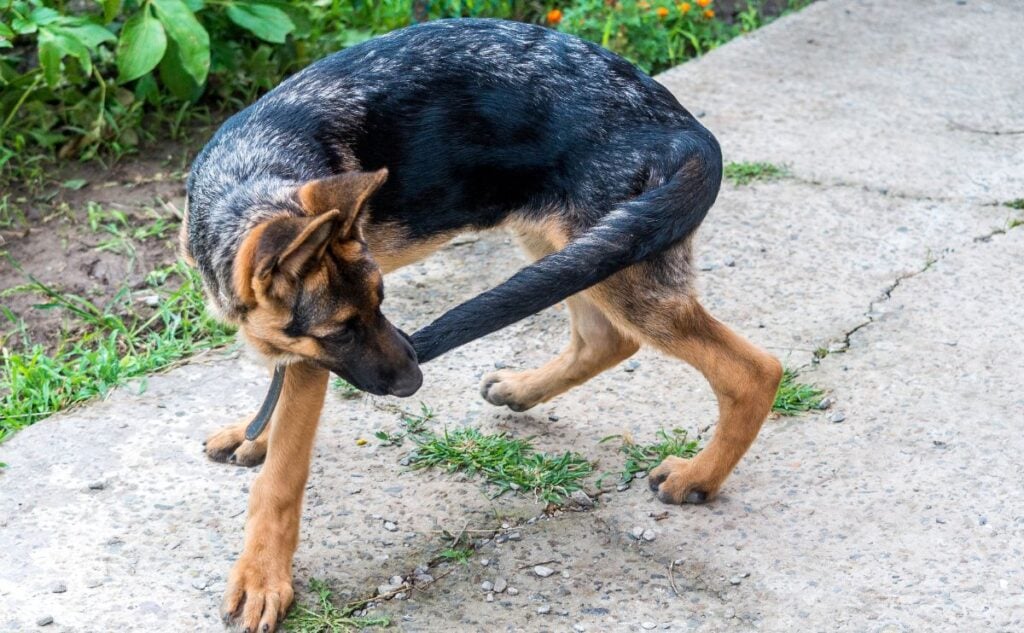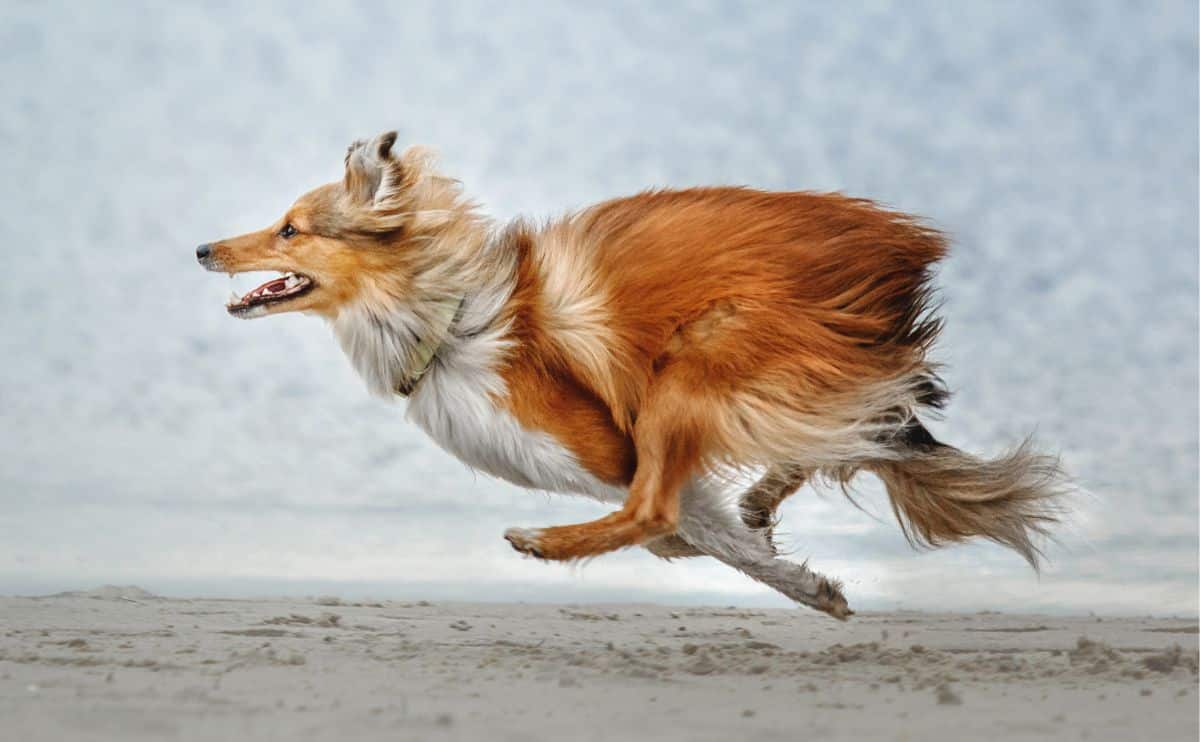The Real Reason Dogs Chase Their Tails (It’s Not What You Think!)
When you purchase through links on our site, we may earn a commission. Here’s how it works.

Is your dog training for the Canine Olympics, or have they simply lost their mind? Watching a dog spin in circles, chasing its own tail, is one of those classic dog behaviors that never fails to entertain. It’s adorable, funny, and sometimes downright impressive. But after the laughter dies down, you might find yourself wondering: why do dogs chase their tails? Is it just a quirky habit, or could it mean something more serious?
Table of Contents
For many dogs, tail-chasing is a harmless form of entertainment, especially for puppies still figuring out how their bodies work. But sometimes, a dog spinning in circles isn’t just playing. It could be a sign of boredom, anxiety, or even a medical issue. If your dog keeps chasing their tail excessively, biting at it, or seeming distressed, it’s worth taking a closer look.
So, how do you tell the difference between normal tail-chasing and a potential red flag? In this article, I’ll break down why dogs chase their tails, when it’s just playful fun, and when it might signal an underlying problem. Whether your pup is simply amusing themselves or trying to tell you something’s wrong, I’ve got the answers you need.
Why Do Dogs Have Tails?

Before I get into why dogs chase their tails, let’s look at why dogs have tails in the first place. A dog’s tail isn’t just a cute accessory – it serves several important purposes. While we often associate tails with wagging, they play a vital role in communication, balance, and survival instincts. Here’s why dogs have tails and how they use them in everyday life.
1. Communication & Social Signals
Dogs may not speak our language, but they have an entire tail-based vocabulary to express their emotions. A wagging tail can mean happiness, excitement, nervousness, or even aggression, depending on how it’s held and moved.
- Fast wag with a relaxed body – Happy and friendly
- Slow, cautious wag – Unsure or nervous
- High, stiff wag – Alert or dominant
- Low, tucked tail – Fear or submission
Dogs use their tails to communicate with other dogs and humans, helping to avoid conflicts and express emotions without a single bark.
2. Balance & Coordination
Ever watched a dog run at full speed, make a sharp turn, and not wipe out? Their tail helps with that. Dogs use their tails for balance, especially when making quick movements, climbing, or navigating tricky terrain.
- Sporting and working breeds, like Border Collies and Labrador Retrievers, rely on their tails for agility and control.
- Greyhounds and Whippets use their tails to stabilize themselves at high speeds.
- Herding dogs use their tails to shift their weight as they maneuver through fields and rough terrain.
Without a tail, some dogs may struggle with coordination. This is why dogs born without tails or those with docked tails may need to adjust their movements.
3. Spreading Scent For Identification
Believe it or not, a dog’s tail is part of their scent-marking system. Near the base of the tail are glands that release pheromones, unique chemical signals that other dogs can smell. When a dog wags its tail, it spreads their scent and signals its presence to other animals. This is why dogs often sniff each other’s rear ends. It’s their way of gathering social information, like who’s in the area and whether they’re friend or foe.
4. Protection & Defense
Some dogs use their tails as a built-in shield. Thick, bushy tails can protect against harsh weather, like how Arctic breeds such as Huskies curl up and cover their noses with their tails to stay warm. Other dogs use their tails defensively – wagging stiffly or raising their tail high as a warning when they feel threatened. Some wild canines, like wolves and foxes, also use their tails to appear larger or signal danger to their pack.
5. Puppy Development & Play
For puppies, tails are a built-in toy and an important part of learning coordination. Young dogs often chase their tails because they’re still discovering how their bodies move. This playful behavior helps develop motor skills and social interaction, which is why puppies often use their tails when playing with littermates.
Is It Normal For Dogs To Chase Their Tails?

The short answer? Mostly normal, but sometimes weird, and sometimes a tell-tale sign that something is wrong. Puppies often chase their tails because they’re playful and still figuring out how their bodies work. Why does my puppy chase their tail so much? Usually, it’s just a fun, new discovery. However, if an adult dog suddenly becomes obsessed with spinning in circles or biting their tail, it could be a sign of an issue like anxiety, compulsive behavior, or a medical problem.
So, how do you know if dog tail-chasing disorder is something to worry about? Let’s look at the most common reasons behind this dizzying habit.
Why Do Dogs Chase Their Tails? 5 Common Causes
Dogs chase their tails for many reasons, and while it often looks like harmless fun, there can be deeper explanations behind this behavior. Some dogs spin in circles out of boredom, while others do it as a learned habit to get attention. In certain cases, tail-chasing can be linked to instinct, medical conditions, or even anxiety. Understanding why your dog is chasing their tail can help you determine whether it’s a playful quirk or a sign of something more serious.
1. Boredom & Playfulness
Sometimes, a tail is just an irresistible built-in toy. Puppies, in particular, are prone to tail-chasing because they are still discovering their bodies and exploring movement. For many young dogs, chasing their tails is part of their natural play behavior and usually nothing to worry about.
In adult dogs, tail-chasing can be a sign of pent-up energy. High-energy breeds like Border Collies, Huskies, and Jack Russell Terriers often need more exercise and mental stimulation than other breeds. If they don’t get enough activity, they may find their own ways to entertain themselves, such as spinning in circles and chasing their tails being one of them.
Tail-chasing from boredom is more common in dogs that spend long hours alone, have limited access to outdoor play, or don’t receive enough interaction from their owners. It can turn into a habit if this behavior happens frequently and isn’t redirected into more constructive activities.
Here’s a few ways how to stop tail-chasing due to boredom:
- Increase daily walks or add in more vigorous exercise, such as running or agility training
- Provide interactive toys, such as treat-dispensing puzzle toys or chew toys
- Schedule regular play sessions with engaging games like tug-of-war or fetch
- Try dog sports or obedience training to give them mental and physical stimulation
If tail-chasing is simply an outlet for energy, increasing exercise and playtime should reduce the behavior over time.
2. Attention-Seeking Behavior
Dogs are incredibly observant, and many quickly learn which behaviors get a reaction from their owners. If every time your dog chases their tail, you laugh, call their name, or even scold them, they may interpret this as attention. To a dog, attention is a reward, even if it’s negative.
Some dogs may develop tail-chasing as a way to entertain their owners, especially if they’ve learned that it makes people smile or interact with them. This is particularly common in social breeds that thrive on human interaction, such as Labrador Retrievers and Golden Retrievers.
Dogs left alone for long periods or not given enough engagement may also resort to tail-chasing as a way to get noticed when their owner is around. The more they receive attention for the behavior, the more likely they are to repeat it.
Here are a few tips on how to stop tail-chasing for attention:
- Ignore the behavior completely when it happens; don’t react at all
- Reward calm behavior with treats and praise to reinforce better habits
- Redirect their focus to a more constructive activity, such as playing with a toy or performing a learned command
- Ensure they are getting enough structured attention throughout the day so they don’t feel the need to act out
Over time, if tail-chasing is ignored and calm behavior is rewarded instead, most dogs will stop doing it for attention.
3. Instinct & Prey Drive
Some dogs chase their tails because their instincts tell them to. Dogs with a high prey drive, such as Terriers, Hounds, and Shepherds, are naturally wired to chase anything that moves, including their own tail. Movement often triggers a dog’s instinctual chase response, even if it’s their own body. Some dogs may become momentarily confused by their tail’s movement and react as if it were a small animal darting away. This is especially common in herding breeds, who have strong instincts to chase and control movement.
In some cases, a dog may not even realize it is their own tail, especially if they have a long, bushy tail that moves erratically when they wag. Instinct-based tail-chasing is usually harmless and sporadic. However, if a dog is frequently fixated on their tail, it may indicate they are not getting enough outlets for their natural instincts.
Here are a few ways how to prevent instinct-driven tail-chasing:
- Provide an appropriate outlet for their prey drive, such as playing with flirt poles or chasing a ball
- Engage in training that channels their instincts, like herding or scent work like barn hunting
- Redirect their energy to puzzle feeders or interactive toys that challenge their mind
Occasional tail-chasing due to instinct is normal, but ensuring your dog has other ways to satisfy their chase drive can reduce the behavior.
4. Anxiety Or Compulsive Behavior
Tail-chasing can sometimes be a sign of underlying anxiety or compulsive tendencies. Dogs experiencing chronic stress or frustration may develop repetitive behaviors, similar to how some humans bite their nails or pace when nervous. Some of the most common triggers for anxiety-based tail-chasing are:
- Loud noises, such as fireworks or thunderstorms
- Separation anxiety, especially in dogs left alone for long periods
- Past trauma, which is more common in rescue dogs
- Lack of socialization or mental stimulation
In severe cases, tail-chasing may become a compulsive disorder. Dogs with compulsive tendencies will engage in repetitive behaviors, such as excessive licking, pacing, or spinning, even when there is no clear trigger.
Here are a few tips on how to reduce anxiety-driven tail-chasing:
- Provide a structured routine to reduce stress
- Use calming aids, such as pheromone diffusers, anxiety wraps, or calming treats
- Increase exercise and mental stimulation to help reduce nervous energy
- Work with a professional dog trainer or behaviorist if compulsive behaviors persist
If tail-chasing is linked to anxiety or compulsion, addressing the root cause is crucial to stopping the behavior.
5. Medical Issues & When To Worry
If a dog suddenly starts chasing their tail more frequently or aggressively, it could be a sign of a medical issue. Several health conditions can cause itching, pain, or discomfort, leading dogs to fixate on their tail. Here are a few of the most common medical causes of tail-chasing:
- Fleas & Skin Irritation. Dogs suffering from flea infestations, allergies, or dry skin may try to bite or chase their tails due to itchiness.
- Anal Gland Problems. Dogs have scent glands near their tail, and when these glands become impacted or infected, it can cause discomfort. A dog may chase their tail or scoot on the floor as a way to relieve the irritation.
- Tail Injuries. If a dog has bruising, a fracture, or nerve damage in the tail, they may react by fixating on it.
- Neurological Disorders. Some dogs, especially breeds like Bull Terriers, may develop neurological conditions that cause compulsive spinning or tail-chasing.
When To See A Vet:
- If the behavior starts suddenly and is frequent
- If the dog is biting or injuring their tail
- If there is hair loss, redness, or swelling on the tail
- If the dog appears in pain or agitated while chasing
A vet can help determine if a medical issue is causing the behavior and recommend appropriate treatment.
How Pet Insurance Can Help

Getting pet insurance is essential for responsible pet ownership because it helps cover unexpected veterinary costs, ensuring that your pet gets the best care while limiting financial strain. Tail-chasing might seem harmless at first. But if it becomes excessive or is linked to medical issues like flea infestations, skin allergies, anal gland problems, or neurological disorders, vet visits and treatments can quickly add up. Pet insurance can help cover diagnostic tests, medications, and even specialist treatments, making it easier to address the underlying cause of tail-chasing before it leads to injury or chronic discomfort.
By having a policy in place, you can focus on finding the right solution for your pet’s health rather than worrying about the costs, giving them a better quality of life and peace of mind for you. Our pet insurance experts have reviewed the best pet insurance. You can also use our pet insurance quote engine to help you find the best coverage for your beloved pup.

How to Stop My Dog From Chasing Their Tail
If your dog’s tail-chasing is becoming excessive, frequent, or obsessive, it’s time to take action. The key to stopping this behavior is identifying the root cause and addressing it directly. Whether the behavior is caused by medical issues, boredom, attention-seeking, or anxiety, the following steps can help curb tail-chasing and prevent it from turning into a long-term problem.
Step 1: Rule Out Medical Issues
Before trying to correct tail-chasing as a behavioral issue, it’s important to rule out any underlying medical problems. If your dog keeps spinning in circles, biting at their tail, or showing signs of distress, schedule a visit with your veterinarian. A vet can perform an examination to determine if a medical condition is at play. If a health issue is identified, treating the underlying problem should help resolve the behavior.
Step 2: Increase Exercise and Mental Stimulation
A bored or under-stimulated dog is more likely to chase their tail out of frustration. High-energy breeds, such as Border Collies, Australian Shepherds, and Huskies, need plenty of exercise and mental enrichment to stay balanced and engaged. To help burn off excess energy and reduce tail-chasing, try incorporating more intensive activities into your dog’s routine, such as longer walks or runs, more interactive dog toys, or agility training. If your dog engages in excessive spinning or hyperactivity, it may be a sign that they need more exercise.
Step 3: Avoid Reinforcing The Behavior
Many owners unintentionally encourage tail-chasing by reacting to it. If your dog has learned that spinning in circles makes you laugh, talk to them, or give them attention, they will continue doing it because, in their mind, it’s a game that gets a reaction. If you laugh, record a video, or call their name, your dog will associate tail-chasing with positive attention. Even adverse reactions, like scolding them, may reinforce the behavior if the dog seeks interaction.
To stop this habit, follow these steps:
- Ignore The Behavior. If your dog starts chasing their tail, don’t react at all. Turn away or leave the room.
- Reward Calm Behavior. When your dog stops spinning and focuses on something else, praise them and offer a treat.
- Redirect Their Attention. Encourage them to play with a toy, chew on a bone, or perform a trained command instead.
The goal is to teach your dog that tail-chasing does not lead to attention, but calm and controlled behaviors do.
Step 4: Reduce Anxiety Triggers
For some dogs, tail-chasing is linked to stress, anxiety, or compulsive behavior. If your dog spins excessively, paces, or engages in repetitive actions, they may be using tail-chasing as a way to cope with anxiety. To help reduce stress-based tail-chasing, identify and minimize the triggers:
- Noise Sensitivity. Loud sounds like fireworks, thunderstorms, or construction noise can stress some dogs. Try playing calming music, using a white noise machine, or providing a quiet space during stressful times.
- Separation Anxiety. If your dog chases their tail when left alone, they may be experiencing separation anxiety. Crate training, hiring a pet sitter, or using interactive toys can help keep them occupied and reduce stress.
- Lack Of Mental Stimulation. Bored dogs with pent-up frustration may develop obsessive behaviors. Try rotating new toys, engaging in scent work, or adding structured play sessions to their routine.
For severe cases where tail-chasing is frequent and compulsive, a veterinarian or canine behaviorist may recommend behavior modification training, anxiety medications, or calming supplements such as CBD oil to help manage the condition. Below, see a video from Dr. David Randall, who also explains why a dog chases its tail and how to curb that behavior.
Frequently Asked Questions
We know many of our readers still have questions about dogs chasing their tails. If you have a question I haven’t listed below, please ask us in the comments section below, and we’ll get back to you with an answer.
Why Do Puppies Chase Their Tails?
Puppies chase their tails for the same reasons dogs do and as a form of exploration. Puppies are learning and discovering many things daily. So when they see their tail’s shadow, they may think it’s a toy, so chasing it is instinctual. Puppies chasing their tails and catching them can help them learn how big they are and distinguish themselves from toys.
Why Does My Dog Chase Their Tail So Much?
Dogs chase their tails for various reasons, including boredom, playfulness, attention-seeking, instinct, anxiety, or medical issues. Puppies often do it as part of exploring their bodies, while adult dogs may chase their tails due to excess energy or learned behavior. If your dog does it frequently and obsessively, it may be worth investigating further.
Is It Normal For Dogs To Chase Their Tails?
Yes, occasional tail-chasing is normal, especially in puppies and high-energy dogs. However, if the behavior becomes excessive, compulsive, or is accompanied by tail biting, licking, or signs of distress, it may indicate an underlying medical or behavioral issue that needs attention.
When Should I Be Concerned About My Dog Chasing Their Tail?
You should be concerned if your dog chases their tail excessively or obsessively, bites or injures its tail, cries or whines while chasing, has hair loss, redness, or swelling on the tail, or suddenly starts chasing their tail more than usual. In these cases, a visit to the vet is recommended to rule out medical issues like fleas, skin infections, anal gland problems, or neurological conditions.
Can Tail-Chasing Be A Sign Of Anxiety?
Yes, some dogs chase their tails as a coping mechanism for anxiety or stress. Dogs with separation anxiety, noise phobias, or obsessive-compulsive tendencies may engage in repetitive behaviors like spinning or tail-chasing to self-soothe. If anxiety is the cause, addressing the stressors and providing mental stimulation can help reduce the behavior.
How Can I Stop My Dog From Chasing Their Tail?
To reduce tail-chasing, start by ruling out any medical issues with a vet visit. Providing more exercise and mental stimulation can help prevent boredom-driven tail-chasing. Avoid reinforcing the behavior by ignoring it and redirecting their focus with toys or training exercises. If anxiety is a factor, address triggers such as loud noises or separation stress. If tail-chasing becomes compulsive, consult a veterinarian or dog behaviorist for additional guidance.
Do Certain Breeds Chase Their Tails More Than Others?
Yes, some breeds are more prone to tail-chasing due to their temperament and instincts. Breeds with high energy levels, strong prey drives, or a genetic predisposition to compulsive behaviors may be more likely to engage in tail-chasing. These include Bull Terriers, German Shepherds, Border Collies, Jack Russell Terriers, and Siberian Huskies. If you own a breed with a tendency for tail-chasing, providing plenty of exercise and mental stimulation can help prevent the behavior from becoming excessive.
Is Tail-Chasing Ever Dangerous For Dogs?
Tail-chasing itself is not dangerous, but if a dog begins biting its tail aggressively, it can lead to wounds, infections, or hair loss. Some dogs may also develop compulsive behaviors that interfere with daily life. If the behavior becomes self-harming or obsessive, intervention is necessary to prevent further issues.
Should I Just Let My Dog Chase Their Tail If They Look Like They’re Having Fun?
If your dog occasionally chases its tail as part of play, there’s no harm in letting them have fun. However, if the behavior becomes excessive, obsessive, or leads to injury, it’s best to step in and redirect their attention to other activities. Monitoring their behavior and ensuring they’re getting enough exercise, interaction, and medical care can help keep them happy and healthy.
Other Strange Dog Behaviors
Dogs have plenty of bizarre behaviors that leave us questioning their logic – or lack of logic! They tilt their heads dramatically when we talk to them, possibly trying to decode our nonsense or just pretending to listen. Then there’s the classic move: sniffing crotches with the confidence of an overenthusiastic detective. And let’s not forget the odd staring while they poop. Worst of all, we also look at why dogs roll in poop. While most of these behaviors are harmless, if your dog takes any of them to an extreme level, it might be worth looking into. Otherwise, just accept that dogs are weird, and that’s why we love them.
Does your dog chase their tail? Do you have a tail-chasing story you’d like to share with us and your fellow readers? Please hit us up in the comments below.
Why Trust Canine Journal?
Emma is a dog mom to two rescue dogs, Bonkers and Chips. Before joining the Canine Journal team, Emma was a full-time dog walker and sitter and has met plenty of tail-chasers in her canine career. She is passionate about sharing her experiences and knowledge with her readers. Emma works with a dedicated team to make Canine Journal a reliable and current go-to online dog resource.



